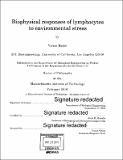| dc.contributor.advisor | Scott R. Manalis. | en_US |
| dc.contributor.author | Hecht, Vivian (Vivian Chaya) | en_US |
| dc.contributor.other | Massachusetts Institute of Technology. Department of Biological Engineering. | en_US |
| dc.date.accessioned | 2016-07-18T20:02:05Z | |
| dc.date.available | 2016-07-18T20:02:05Z | |
| dc.date.issued | 2016 | en_US |
| dc.identifier.uri | http://hdl.handle.net/1721.1/103693 | |
| dc.description | Thesis: Ph. D., Massachusetts Institute of Technology, Department of Biological Engineering, 2016. | en_US |
| dc.description | Cataloged from PDF version of thesis. "February 2016." | en_US |
| dc.description | Includes bibliographical references (pages 139-151). | en_US |
| dc.description.abstract | Cellular biophysical properties both reflect and influence cell state. These parameters represent the consequences of the interactions of multiple molecular events, and thus may reveal information otherwise obscured when measuring individual pathways in isolation. Previous work has demonstrated how precise measurements of certain of these properties, such as mass, volume, density and deformability using a suspended microchannel resonator (SMR) can help characterize cellular behavior and physiological role. Here, we expand upon this previous work to demonstrate the necessity of measuring multiple parameters simultaneously to fully determine cellular responses to environmental perturbations, and describe a situation in which changes to density and size promote survival under conditions of limited nutrient availability. We first investigate the relationship between cell density, volume, buoyant mass, and passage time through a narrow constriction under a variety of environmental stresses. Osmotic stress significantly affects density and volume, as previously shown. In contrast to density and volume, the effect of an osmotic challenge on passage time is relatively small. Deformability, determined by comparing passage times for cells with similar volume, exhibits a strong dependence on osmolarity, indicating that passage time alone does not always provide a meaningful proxy for deformability. Finally, we find that protein synthesis inhibition, cell cycle arrest, protein kinase inhibition, and cytoskeletal disruption result in unexpected relationships between deformability, density, and volume. Taken together, our results suggest that measuring multiple biophysical parameters can detect unique characteristics that more specifically reflect cellular behaviors. We next examine how cellular biophysical changes occurring immediately after growth factor depletion in lymphocytes promote adaptation to reduced nutrient uptake. We describe an acute biophysical response to growth factor withdrawal, characterized by a simultaneous decrease in cell volume and increase in cell density prior to autophagy initiation, observed in both FL5.12 cells depleted of IL-3 and primary CD8+ T cells depleted of IL-2 and differentiating towards memory cells. The response reduces cell surface area to minimize energy expenditure while conserving biomass, suggesting that the biophysical properties of cells can be regulated to promote survival under conditions of nutrient stress. | en_US |
| dc.description.statementofresponsibility | by Vivian Hecht. | en_US |
| dc.format.extent | 151 pages | en_US |
| dc.language.iso | eng | en_US |
| dc.publisher | Massachusetts Institute of Technology | en_US |
| dc.rights | MIT theses are protected by copyright. They may be viewed, downloaded, or printed from this source but further reproduction or distribution in any format is prohibited without written permission. | en_US |
| dc.rights.uri | http://dspace.mit.edu/handle/1721.1/7582 | en_US |
| dc.subject | Biological Engineering. | en_US |
| dc.title | Biophysical responses of lymphocytes to environmental stress | en_US |
| dc.type | Thesis | en_US |
| dc.description.degree | Ph. D. | en_US |
| dc.contributor.department | Massachusetts Institute of Technology. Department of Biological Engineering | |
| dc.identifier.oclc | 953183345 | en_US |
